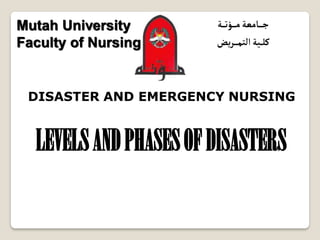
4 levels and phases of disasters.pdf
- 1. 1 ج ــــ مامعة ــــ ؤت ـــ ة كل ــ التمية ــــ ريض DISASTER AND EMERGENCY NURSING Mutah University Faculty of Nursing LEVELSANDPHASESOFDISASTERS
- 2. Levels of disaster Level III disaster: considered a minor disaster. These are involves minimal level of damage. Level II disaster: considered a moderate disaster. The local and community resources has to be mobilized to manage this situation. Level I disaster: considered a massive disaster- this involves a massive level of damage with severe impact. 2
- 3. Characteristics of a disaster 1. Cause, natural or man-made. 2. Causality Is a human being who is injured or killed by or as a direct result of an accident. a. Multiple causality incident the no. of causalities more than 2 and less than hundred. b. Mass causality a number of victims that is greater than that which can be managed safely with the resources the community has to offer incident involving 100 or more and overwhelms the resources of large cities. 3
- 4. Characteristics of a disaster 3. Time, speed, and duration. 4. Scope: range of its effect, geography or no. of victims. 5. Intensity: the level of destruction and damage. 6. Predictability 7. Frequency 8. Controllability/Mitigation 9. Community Implications 4
- 5. Victims of disaster Victims are characterized by the level of involvement. 1. Direct victims: are people experiencing the event, dead, survivors even with no physical injury, they are likely to have health effect from the experience. ( some have no shelter or food). Displaced persons are forced to leave their home to escape the effect of the disaster. Refugee are people who are forced to leave their homeland because of war or persecution 2. Indirect victims : are the relatives and friends of direct victims. 5
- 6. Factors contributing to disaster To understand the factors, apply host, agent, and environment model because it is useful in planning strategies to prevent or prepare for disaster. 1. Host Factors: host is the person who experiences the disaster. The host factors includes; age, general health, mobility, psychological factors and socioeconomic ones. 2. Agent Factors: agent is the natural or technological element that causes the disaster. E.g. high wind of hurricane, radiation and industrial chemicals. 6
- 7. Factors contributing to disaster 3. Environmental Factors: are factors that potentially contribute to or mitigate a disaster. Most common factors includes: 1. community’s level of preparedness. 2. Presence of industries 3. Rivers, lakes, streams, rain and snow flow 4. High and low temperatures 5. Presence or absence of political unrest. 7
- 8. The Phases of Disaster Prevention or (prei-mpact) Preparedness (Impact) Response (Post impact) Recovery (rehabilitation) 8
- 10. Nurses role Nursing can contribute to prevention, mitigation, preparedness, response, and recovery. Nurses work systematically by gathering data, planning according to priorities to target all who might benefit, working skillfully to promote health of the community, and evaluating the outcomes.
- 11. DISASTER PREVENTION OR MITIGATION Disaster mitigation refers to actions or measures that can either prevent the occurrence of a disaster or reduce the severity of its effects. (American Red Cross). Mitigation activities include awareness and education and disaster prevention measures Examples ◦ Immunization programs ◦ Public education 11
- 12. Pre-impact Pre-impact ◦ Occurs prior to the onset of the disaster ◦ Include the period of threat and warning ◦ May not occur in all disasters. 12
- 13. PREPAREDNESS impact Activities that are taken to build capacity and identify resources that may be used to handle a disaster when it strikes at local, regional and national levels (community, personal, and professional preparedness). E.g. ◦ Know evacuation shelters ◦ Emergency communication plan ◦ Preventive measures to prevent spread of disease ◦ Public Education ◦ Period of time when disaster occurs continuing to immediately following disasters ◦ Inventory and rescue period ◦ Assessment of extent of losses and ◦ Identification of remaining sources ◦ Planning for use of recourses and rescue of victims and minimize further injuries and property damage 13
- 14. Preparedness Non-health care community ◦Fire fighters ◦Municipal or government officials ◦Media ◦Medical examiners ◦Medical supply manufactures ◦Police 14
- 15. Preparedness Key organizations and professionals in disaster management Health care community ◦ Hospitals ◦ Health professionals ◦ Pharmacies ◦ Public health departments ◦ Rescue personnel 15
- 16. Preparedness Community preparedness The level of community preparedness for a disaster is only as high as the people and organization in the community make it. Community must have adequate warning system and a back up evaluation plan to remove people from the area of danger 16
- 17. Response The level of disaster varies and the management plans mainly based on the severity or extent of the disaster. Activities a hospital, healthcare system, or public health agency take immediately, during, a disaster or emergency occurs 17
- 18. Recovery During this phase actions are taken to repair, rebuilt, or reallocate damaged homes and businesses and restore health and economic vitality to the community. Psychological recovery must be addressed. Both victims and relief workers should be offered mental health activities and services. ◦ Debris Removal ◦ Care and Shelter ◦ Damage Assessments ◦ Funding Assistance 18
- 19. Components of disaster debris Building Debris Household Debris Vegetative Debris Problem Waste Streams 19
- 20. Myths associated with disasters Any kind of assistance needed in disasters A response not based on impartial evaluation contributes to chaos Epidemics and plagues are inevitable after every disaster Epidemics rarely ever occur after a disaster Dead bodies will not lead to catastrophic outbreaks of exotic disease Proper resumption of public health services will ensure the public’s safety (sanitation, waste disposal, water quality, and food safety) Disasters bring out the worst in human behavior The majority responses spontaneous and generous The community is too shocked and helpless Cross-cultural dedication to common good is most common response to natural disasters. 20